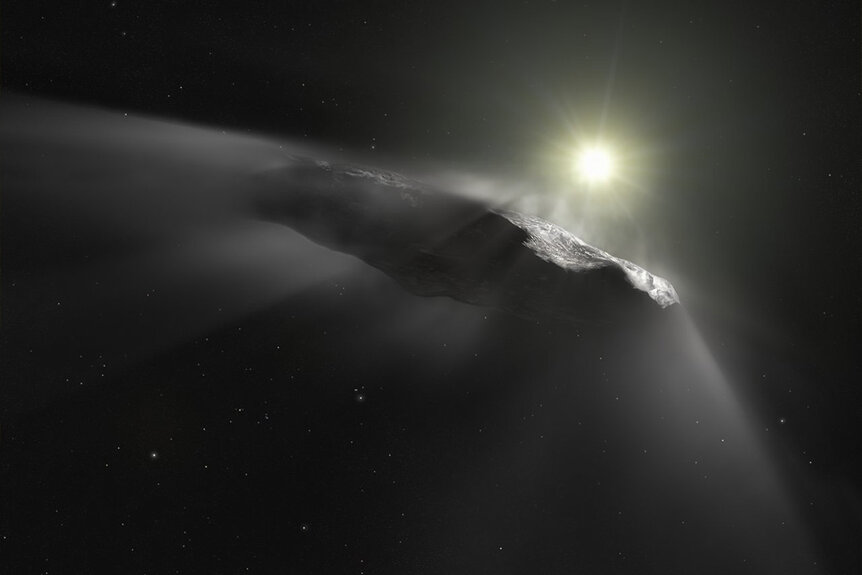Create a free profile to get unlimited access to exclusive videos, sweepstakes, and more!
‘Oumuamua’s weird motion has an explanation, and it isn’t aliens
Unless...

In October of 2017, astronomers were surprised to find a 400-meter object hurtling through our solar system, seemingly from interstellar space. Certainly, it wasn’t the first rogue object to cruise through our neck of the woods, but it was the first one we ever noticed. So, the astronomers who first discovered it named it ‘Oumuamua, Hawaiian for “a messenger from afar arriving first.”
That would have been enough to get ‘Oumuamua plastered all over the headlines, but it was weird too, and that helped. Rather than the potato-shaped rocks we’re used to seeing, ‘Oumuamua was a quarter-mile-long, slender like a cigar or a submarine, and tumbling end over end. It stuck out against the crowd because it was moving fast, fast enough that it escaped the gravity of the Sun and flung itself right out of the solar system again. Strangely, however, astronomers couldn’t fully account for its velocity through gravity alone. While our opportunity to observe ‘Oumuamua was limited, it appeared to be accelerating with no visible means of propulsion. The combination of its unusual shape, unexplained motion, and interstellar origin were enough to birth more than a few wild ideas about the object’s true nature, including that it was a piece of extraterrestrial technology.
That idea even made its way into a Season 2 episode of SYFY's Resident Alien (now streaming on Peacock). In the episode “Radio Harry,” Harry (Alan Tudyk) builds a communications device out of scraps and takes it to a high mountain peak in order to maximize his odds of making a connection. Harry explains that his device will connect with a passing alien radio transmitter, locally known as ‘Oumuamua, allowing him to communicate with his own people.
RELATED: 'Oumuamua: Resident Alien's radio receiver isn't alien tech, but it is awesome!
In the years since we spied ‘Oumuamua in the night sky, we’ve identified a handful of additional interstellar objects, including one which crash landed on Earth after millions of years or more traveling through the dark space between stars. As we get better at identifying these celestial interlopers and launch new instruments for studying the universe, it’s likely we will realize that our own backyard is littered with alien baseballs thrown over the cosmic fence. Future missions might provide the opportunity to study one of these objects up close, but until then, scientists have to rely on laboratory experiments and math to recreate the sorts of conditions objects like ‘Oumuamua might experience.
Assuming it wasn’t a piece of alien communications technology, scientists from Cornell and the University of California, Berkeley set out to explain ‘Oumuamua’s weird acceleration on its way through the solar system. Their results were published in the journal Nature.
The exact composition of ‘Oumuamua isn’t known and has been the subject of some speculation. Previous explanations for the unusual behavior include exotic materials uncommon to our solar system, interacting in ways we don’t fully understand, but the new paper needs none of that.
Researchers imagine ‘Oumuamua as a water-rich icy comet, not too unlike the ones you’re already familiar with. Over the course of its interstellar travels, it would have been exposed to cosmic radiation which interacted with the water ice. Over time, molecules break apart, liberating hydrogen inside the ice. That hydrogen could then collect in pockets, inside the ice, waiting to be set free.
The researchers believe that as ‘Oumuamua approached the Sun, it was struck by a warmth it hadn’t felt in millions of years, maybe longer. That warmth melted some of the surface ice, but even the interior resettles as the interior heats up. All of that action opened up fissures and subterranean pockets, allowing the collected hydrogen to vent into space and give ‘Oumuamua a boost.
It’s a reasonable hypothesis, but one scientists couldn’t test directly. At the time of writing, ‘Oumuamua is roughly 5.3 billion kilometers away, farther than the distance to Pluto, and too small to see. To test their idea, scientists ran the numbers to see if their explanation held up to scrutiny.
First, they calculated the amount of hydrogen an object like ‘Oumuamua could reasonably store, a variable they called the H2 budget. Then they produced a thermodynamic model of the object, illustrating its interior temperature. Then it was a matter of seeing if there was enough hydrogen to start with, and if enough of it could be liberated, to explain the acceleration astronomers observed. When all components were tallied and all of the ones carried, everything fit together. And they didn’t have to invent a single alien starship engine to make it work.
Although, maybe that’s what the alien invaders want us to think! Best to prepare for the worst, with Resident Alien, streaming now on Peacock!



























